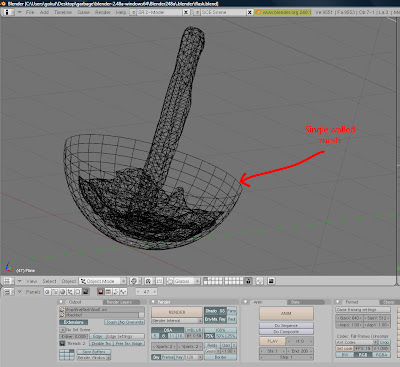 w up.
w up.The Script consists of the introductory level of the game, divided into 5 sublevels.
- Objects involved : in this level are are a ball and a domino.
- Objective : Hit the Domino with the ball.
- Elaboration : The starting position of the ball is atop the inclined pedestal. Using various building blocks from the vault provided, the player has to provide a pathway for the ball to go and collide with the domino.
LEVEL 1A:
The ball starts atop the pedestal with the target domino directly in its line of motion. All that the player has to do is add the ramp to allow the ball to smoothly slide down.
The image alongside shows the level being played in the Game Engine.
LEVEL 1B:
The idea here was to raise the target domino onto a pedestal itself so that the player has to add 2 facing ramps allowing the ball to climb up. Here is the first cut :
Both the starting and ending pedestals are at the same height. What Nitin and I discovered is that since the Game engine provides real world physics, the potential energy of the ball is not conserved, which is why it cannot climb upto the original height. (The ball in the GE mode on the right is at its highest attainable height). So we tried to overcome the damping effect on the SHM by setting damp and rotdamp to 0, to no avail. On Nitin's advice I posted the problem on Blenderartists.org where I got a temporary fix:
The height of the starting ramp is increased, fixing the problem.
LEVEL 1C:
The target domino is shifted out of the line of the ball's motion
One simple solution for the player is to add the pamp and a few dominoes in such a way that consecutive falling of the dominoes finally hit the target domino (highlighted in pink).
LEVEL 1D:
The domino, out of the ball's path has been raised onto a pedestal. The player can add 2 facing ramps and dominoes to overcome this. The level has not been completed due to the same problems faced in level 1B, and will be posted when completed.
LEVEL1E:
The final stage of Level1. The target domino is in the ball's direct path but is atop a flight of stairs.
One simple solution is to add dominoes on each step so that due to the 'domino effect' the target domino falls.
Another idea that I had is to have a camera fly through (as seen tby the ball) in case the player has successfully placed the blocks. The idea is to play the contraption in perspective view if the arrangement is not accurate and then directly have the fly through if the target is going to be hit, so that the player directly knows he has succeeded the moment the fly through begins. A minor variation to the standard way of things, this remains to be discussed with my team
Another important thing is the deadlines. I am reposting the original schedule here :
8th January - Create a Wiki space.
12th January - Survey of games by Bhairav and team.
18th January - Design of Interface to be submitted.
23rd January - Script of the Game
7th February - Modeling of Objects
14th February - Texturing of Objects.
21st February - Lighting
7th March - Game Engine and scripting
28th March - Rendering Starts
5th April - Testing of game
15th April - Final Product
Although we have been off, I think we can be back on track before the 28th March deadline for the commencement of rendering.
The lack of documentation shall be made up for too, so expect frequency of posts to go up.
Chirag Nitin and Kaeyur.




 Here is the list of objects modelled:
Here is the list of objects modelled:












